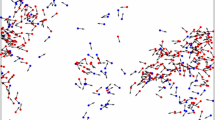Abstract
We propose models describing the collective dynamics of two opposing groups of individuals with stochastic communication. Individuals from the same group are assumed to align in a stochastic manner, while individuals from different groups are assumed to anti-align. Under reasonable assumptions, we prove the large time behavior of separation, in the sense that the variation inside a group is much less than the distance between the two groups. The separation phenomena are verified by numerical simulations.


Similar content being viewed by others
Notes
From now on, summations in \(i,i^{\prime }\) always run from 1 to N1, and \(j,j^{\prime }\) from 1 to N2. \({\sum }_{i^{\prime }\ne i}\) means summation over the index \(i^{\prime }\) which is not equal to i.
Notice that 0 is the smallest eigenvalue of A with eigenvector \((1,\dots ,1)^{T}\).
In the rest of this proof, different C may denote different constants which are all independent of N.
This means that at time T the two groups are separated by the perpendicular bisector of the segment connecting \(\bar {\mathbf {x}}(T)\) and \(\bar {\mathbf {y}}(T)\).
Without this normalization, xi(t) and yj(t) may exhibit exponential growth in time, which makes it hard to demonstrate the extent of separation.
References
Abbe, E.: Community detection and stochastic block models: recent developments. J. Mach. Learn. Res. 18, 6446–6531 (2017)
Bellomo, N., Herrero, M., Tosin, A.: On the dynamics of social conflicts: looking for the black swan. Kinet. Relat. Models 6, 459–479 (2013)
Bertozzi, A., Carrillo, J.A., Laurent, T.: Blow-up in multidimensional aggregation equations with mildly singular interaction kernels. Nonlinearity 22, 683–710 (2009)
Blondel, V.D., Hendricks, J.M., Tsitsiklis, J.N.: On Krause’s multi-agent consensus model with state-dependent connectivity. IEEE Trans. Autom. Control 54, 2586–2597 (2009)
Cucker, F., Smale, S.: Emergent behavior in flocks. IEEE Trans. Autom. Control 52, 852–862 (2007)
Cucker, F., Smale, S.: On the mathematics of emergence. Jpn. J. Math. 2, 197–227 (2007)
Degond, P., Motsch, S.: Continuum limit of self-driven particles with orientation interaction. Math. Model Methods Appl. Sci. 18, 1193–1215 (2008)
Düring, B., Markowich, P., Pietschmann, J.-F., Wolfram, M.-T.: Boltzmann and Fokker–Planck equations modelling opinion formation in the presence of strong leaders. Proc. R. Soc. Lond. Ser. A Math. Phys. Eng. Sci. 465, 3687–3708 (2009)
Fang, D., Ha, S.-Y., Jin, S.: Emergent behaviors of the Cucker–Smale ensemble under attractive-repulsive couplings and Rayleigh frictions. Math. Models Methods Appl. Sci. 29, 1349–1385 (2019)
Ha, S.-Y., Ha, T., Kim, J.-H.: On the complete synchronization of the Kuramoto phase model. Phys. D: Nonlinear Phenom. 239, 1692–1700 (2010)
Ha, S.-Y., Tadmor, E.: From particle to kinetic and hydrodynamic descriptions of flocking. Kinet. Relat. Models 1, 415–435 (2008)
He, S., Tadmor, E.: Suppressing chemotactic blow-up through a fast splitting scenario on the plane. Arch. Rational Mech. Anal. 232, 951–986 (2019)
Hegselmann, R., Krause, U.: Opinion dynamics and bounded confidence: Models, analysis and simulation. J. Artif. Soc. Soc. Simul. 5, 3 (2002)
Holland, P.W., Laskey, K.B., Leinhardt, S.: Stochastic blockmodels: first steps. Soc. Netw. 5, 109–137 (1983)
Jin, S., Li, L., Liu, J.-G.: Random Batch Methods (RBM) for interacting particle systems. J. Comput. Phys. 400, 108877 (2020)
Juhász, F.: The asymptotic behavior of Fiedler’s algebraic connectivity for random graphs. Discrete Math. 96, 59–63 (1991)
Motsch, S., Tadmor, E.: Heterophilious dynamics enhances consensus. SIAM Rev. 56, 577–621 (2014)
Toscani, G.: Kinetic models of opinion formation. Commun. Math. Sci. 4, 481–496 (2006)
Acknowledgements
SJ was partially supported by NSFC grants Nos. 31571071 and 11871297. RS was supported in part by NSF grants DMS16-13911, RNMS11-07444 (KI-Net) and ONR grant N00014-1812465.
Author information
Authors and Affiliations
Corresponding author
Additional information
Publisher’s Note
Springer Nature remains neutral with regard to jurisdictional claims in published maps and institutional affiliations.
Dedication to Prof. Enrique Zuazua on the occasion of his 60th birthday.
Rights and permissions
About this article
Cite this article
Jin, S., Shu, R. Collective Dynamics of Opposing Groups with Stochastic Communication. Vietnam J. Math. 49, 619–636 (2021). https://doi.org/10.1007/s10013-020-00430-2
Received:
Accepted:
Published:
Issue Date:
DOI: https://doi.org/10.1007/s10013-020-00430-2




